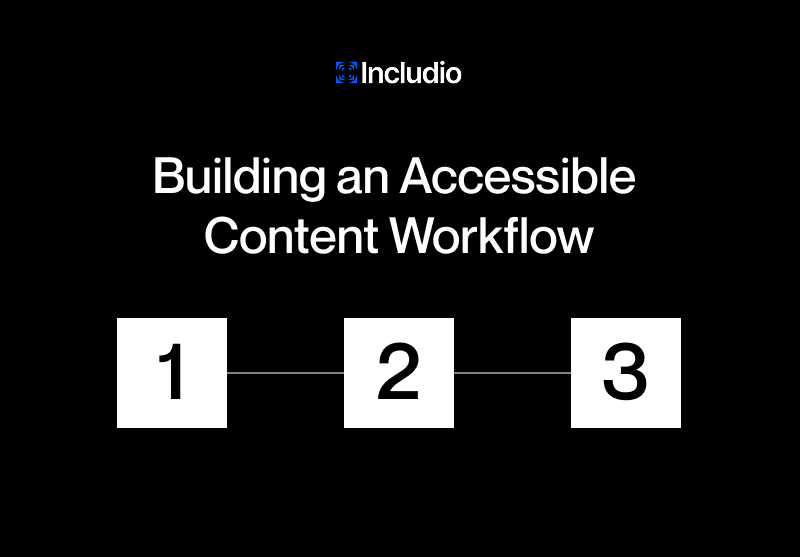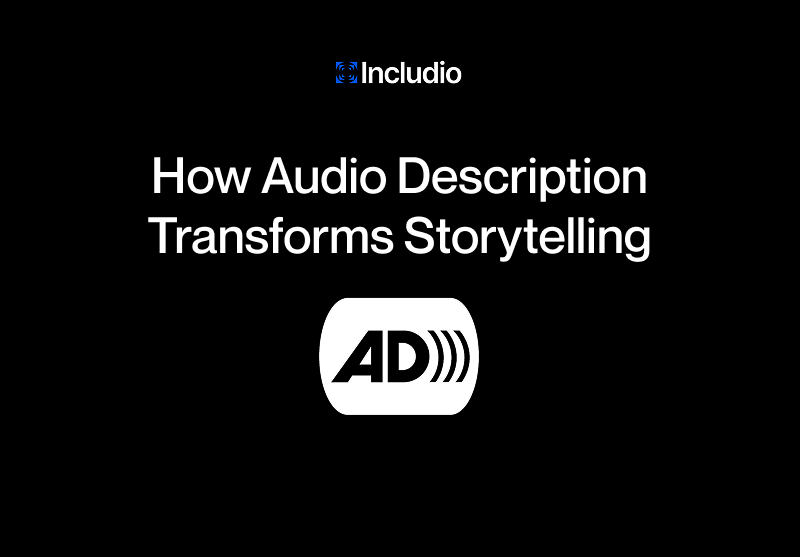
The 5-Step Guide
Every piece of media you create should reach every viewer. Accessibility ensures your videos, films, and broadcasts are available to everyone, including people with disabilities. Regulations such as the European Accessibility Act and WCAG 2.1 make this a legal and professional responsibility. Despite this, many teams are unsure how to evaluate their current accessibility performance.
A structured accessibility media audit solves that problem. It gives you clear, measurable insight into where your content meets standards and where it falls short. The process identifies compliance risks, missing features, and opportunities to improve your production workflow. By following these five steps, your team can audit subtitles, audio description (AD), and overall video accessibility with confidence.
Step 1: Review Current Accessibility Features
Start with an inventory of your current accessibility features. Gather every available file type, including subtitles, captions, AD tracks, and transcripts. Document which videos have them, which do not, and how consistent the formatting is across your content library.
Use a checklist to guide your review:
● Do all videos include subtitles that match the spoken dialogue?
● Are AD tracks available and correctly synced with visuals?
● Are captions consistent in style and readable on all devices?
● Do your files meet recognized accessibility standards like WCAG 2.1 or EAA 2025?
This step establishes a baseline for your inclusive content audit. It helps you identify where your team already performs well and where accessibility gaps exist.
Step 2: Check Subtitle and Caption Accuracy
Subtitles and captions make up most accessibility compliance failures. A small error in timing or phrasing can disrupt understanding. Review all subtitle and caption files carefully.
Key points to assess:
● Timing accuracy: Ensure subtitles appear in sync with spoken words and maintain consistent pacing throughout each scene.
● Readability: Check line length, font clarity, color contrast, and placement on the screen to make sure viewers can follow without distraction.
● Speaker labeling: Identify who is speaking when multiple voices overlap or shift quickly in dialogue.
● Sound description: Include cues for sounds like [phone rings], [applause], or [door slams] to give viewers full context of what is happening in the scene.
During your accessibility checklist video process, verify that every subtitle follows proper formatting. Always include human review. Automatic tools save time but cannot match human understanding of tone and emotion.
Example: If a video has 300 lines of dialogue, each subtitle must be displayed for at least one second, no more than two lines per screen. This level of detail improves comprehension and readability.
Step 3: Evaluate Audio Description (AD)
AD provides spoken narration for key visual details. It describes expressions, movements, and transitions that are not heard in dialogue. Many teams skip this step, yet it is essential for true accessibility.
Your accessibility media audit should cover:
● AD availability: Does every major video have a descriptive track?
● Narration pacing: Is the voice clear and well-timed with visuals?
● Script quality: Does the description match the tone of the production?
● File integration: Are AD tracks easy to activate across all platforms?
A full review ensures consistency across your content library. If your videos do not include AD, plan to add it first to flagship or high-traffic titles. This addition strengthens compliance and shows visible commitment to accessibility.
Step 4: Test Technical Compliance and Playback
Accessibility also depends on technical performance. Test how your videos function for viewers using assistive technologies like screen readers or keyboard navigation. Run your audit across multiple devices and platforms. Check these technical elements:
● Subtitles display correctly on phones, tablets, and TVs.
● AD tracks load properly and do not conflict with main audio.
● Media players support keyboard shortcuts and text scaling.
● Metadata includes alt text and accessibility tags.
Track performance on each platform and browser. For example, a video that plays perfectly on YouTube may fail to show captions correctly on internal CMS players. Document every playback issue and share it with your technical team. These reports help prevent accessibility complaints and user frustration.
Step 5: Build an Accessibility Improvement Plan
Once your audit is complete, turn the findings into a detailed improvement plan that your team can act on. This is where your inclusive content audit becomes part of a long-term accessibility strategy that builds accountability and measurable progress.
Your plan should include:
● A full list of missing features such as subtitles, captions, transcripts, or AD.
● A timeline for updates, organized by priority and audience impact.
● Assigned roles for accessibility review, implementation, and sign-off.
● Regular audit cycles every six to twelve months with documented progress reports.
● Benchmarks for each content type to track progress and performance.
Add measurable targets and metrics to guide your improvement efforts. For example, aim to increase AD coverage by 50 percent within one quarter, update all captions for accuracy and readability, or align 90 percent of video assets with WCAG 2.1 standards by year-end. Tracking these metrics turns accessibility into a predictable workflow, strengthens compliance, and provides a clear view of how your content improves over time.
Ongoing Accessibility Training and Reassessment
Accessibility standards evolve. Ongoing training ensures your team stays compliant. Host refresher sessions every few months to review changes in accessibility laws and best practices.
Topics to include in training:
● Writing accurate and natural AD scripts.
● Creating readable subtitles for multilingual audiences.
● Testing media players for new accessibility features.
● Using accessibility auditing tools effectively.
Periodic reassessment keeps your accessibility media audit relevant and accurate. It also builds a culture of responsibility where accessibility becomes routine in your workflow.
Common Mistakes to Avoid
Even experienced production teams make small but costly errors during an accessibility media audit. These mistakes can lead to missed compliance deadlines and lower audience satisfaction.
Here are the most common issues found in accessibility reviews:
● Relying only on auto-generated subtitles instead of human-edited files.
● Forgetting to include AD for new uploads or short-form videos.
● Ignoring archived or legacy content that still appears on your website or channel.
● Skipping playback testing on mobile, tablets, and smart TVs.
● Failing to document updates, assign accountability, or maintain version control.
Each of these mistakes limits progress and weakens your inclusive content audit results. Regular testing, documentation, and human review ensure every video meets accessibility standards across all devices and platforms.
When auditing your content, keep a consistent checklist to verify subtitle accuracy, AD availability, and compliance against WCAG 2.1 and EAA 2025 standards. Avoiding these errors saves production time, reduces costly rework, and strengthens your overall accessibility checklist video process.
Why a Professional Accessibility Audit Matters
A professional accessibility media audit provides expert evaluation and actionable results. It highlights compliance risks under the European Accessibility Act, WCAG 2.1, and regional laws. More importantly, it ensures your brand remains trustworthy and inclusive.
Teams that complete regular audits report significant improvements:
● Up to 40 percent faster approvals for public broadcast.
● A 20 to 30 percent increase in viewer satisfaction.
● 50 percent fewer compliance errors during regulatory checks.
These audits also help standardize internal processes, improving quality control across your team. They create a measurable path toward complete accessibility.
Next Steps: Schedule Your Accessibility Review
Ready to evaluate your content? Talk to an expert or book your accessibility review with Includio. Our specialists assess subtitles, AD, captions, and compliance across your entire media library. We help you identify strengths, fix weaknesses, and build a lasting accessibility strategy that aligns with legal requirements and industry best practices.




